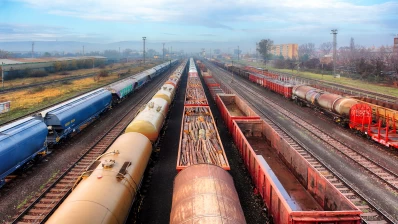- By Della tj
- September 29, 2025
- Rail Freight, Shipping
The China to Europe freight train is transforming logistics for global importers and exporters. It provides faster transit than ocean freight and more affordable options than air freight, making it a balanced solution in today’s supply chain environment.
What Is the China to Europe Freight Train?
The China to Europe freight train, also called the China–Europe Railway Express, links Chinese cities such as Chongqing, Yiwu, Zhengzhou, and Wuhan with European hubs like Duisburg, Hamburg, and Madrid. Covering more than 13,000 km, it passes through multiple customs borders, enabling stable and predictable trade between Asia and Europe.
How Does Rail Compare with Air and Sea Freight?
| Mode | Transit Time | Cost Level | Key Advantages | Key Disadvantages |
|---|---|---|---|---|
| Sea Freight | 30–45 days | Lowest | High capacity, cheapest | Very slow, port congestion |
| Rail Freight | 14–20 days | Moderate | Faster than sea, cheaper than air | Limited routes, customs stops |
| Air Freight | 5–9 days | Highest | Fastest, most reliable | Expensive, strict weight limits |
Accordingly, rail freight is often chosen for mid-speed, mid-cost balance.
What Are the Costs of China to Europe Freight Train?
Rail freight pricing depends on container type, cargo volume, and season.
| Container Type | Average Rate (USD) | Notes |
|---|---|---|
| 20GP (FCL) | $4,800–$6,200 | Best for smaller full loads |
| 40GP (FCL) | $7,500–$9,000 | Popular for machinery, textiles |
| 40HQ (FCL) | $8,000–$9,800 | High-capacity option |
| LCL (per CBM) | $180–$220 | Flexible for small shipments |
During peak export months, costs may rise 10–15%.

How Long Does It Take from China to Europe by Train?
Typical transit times range from 14 to 20 days, depending on route and customs conditions.
| Route | Transit Time |
|---|---|
| Chongqing – Duisburg (Germany) | 16–18 days |
| Wuhan – Lodz (Poland) | 14–16 days |
| Yiwu – Madrid (Spain) | 18–20 days |
| Zhengzhou – Hamburg (Germany) | 15–17 days |
This speed makes it highly competitive against sea freight.
What Documents Are Required for Rail Freight?
Businesses must prepare essential paperwork to ensure customs clearance:
| Document | Purpose |
|---|---|
| Commercial Invoice | Declares value and buyer-seller details |
| Packing List | Lists weight, dimensions, contents |
| Rail Waybill | Transport contract for the shipment |
| Export Declaration | Mandatory for Chinese customs |
| Import Declaration | Required at EU entry |
| Certificate of Origin | Confirms production country |
Accurate paperwork reduces border delays and penalties.
Real Case Studies of China–Europe Rail Freight
Case 1: Shenzhen – Hamburg
- Cargo: Electronics, 20 tons
- Mode: 40HQ container
- Cost: $9,200
- Transit Time: 17 days
- Benefit: Saved 12 days compared to sea shipping.
Case 2: Yiwu – Warsaw
- Cargo: Fashion garments, 12 tons
- Mode: LCL rail
- Cost: $210/CBM, total $6,300
- Transit Time: 15 days
- Benefit: Balanced cost and time for seasonal retail.
What Are the Advantages and Challenges?
Advantages:
- Faster than sea freight
- Lower cost than air freight
- Eco-friendly, lower CO₂ emissions
- Reliable schedules and growing routes
Challenges:
- Customs inspections at borders
- Seasonal congestion
- Limited flexibility for non-rail cities
- Restrictions on dangerous goods
How to Choose the Right Rail Freight Forwarder?
When selecting a logistics partner, consider:
- Experience with China–Europe rail routes
- Transparent cost structures
- Customs clearance expertise
- Real-time tracking and updates
- Multimodal solutions (rail + truck or sea)
A trusted forwarder ensures smooth deliveries across Eurasia.
Future Trends in China–Europe Rail Shipping
The freight train market is expanding with:
- Integration of digital cargo tracking
- Improved container availability
- Expansion into Southern and Eastern Europe
- Growing focus on sustainable logistics solutions
Without a doubt, rail freight will remain vital for companies balancing cost, speed, and environmental responsibility.
Conclusion
To summarize, the China to Europe freight train offers importers and exporters a strategic balance between cost and transit time. With proper documentation, trusted freight forwarders, and awareness of customs requirements, businesses can streamline supply chains while reducing environmental impact. Choosing rail freight is an effective way to strengthen logistics between Asia and Europe.
- Consult TJ China Freight Forwarding for the lowest quote. They will provide you with reliable, cost-effective service.
FAQs
Q1.How much does it cost to ship one container by rail from China to Europe?
Costs range between $4,800 and $9,800 per container, while LCL averages $180–$220 per CBM.
Q2.What is the transit time from China to Poland by rail?
Shipments from Wuhan to Lodz usually take 14–16 days, offering faster delivery compared to ocean shipping.
Q3.Can small importers use rail freight?
Yes, small businesses can choose LCL services, paying only for the space used within a shared container.
Q4.Are hazardous goods allowed on the freight train?
No, hazardous and explosive materials are restricted, requiring special handling or alternative transport options.
Q5.How environmentally friendly is rail freight?
Rail emits about 80% less CO₂ compared to air, making it one of the most sustainable transport choices.

